Just before the 2020 Chinese New Year, a pneumonia caused by a novel coronavirus broke out in Wuhan and then spread across China, igniting an all-out battle against the epidemic.
Facing the outbreak, some have risked their lives to fight on the front lines. Those who brave the storm demonstrate a strong sense of responsibility. Countless people are standing up to adversity in tough times. As soon as the epidemic struck, scientists, doctors, nurses and military medics rushed to Wuhan to save lives. Upon hearing that Hubei suffered shortages of medical supplies, people from other parts of the country as well as countries around the world offered a helping hand by donating cash and materials. Donations from both home and abroad swarmed to the front lines of epidemic control. Taxi drivers, construction workers, street vendors and delivery couriers are joining community workers and volunteers to make huge contributions to the fight against the epidemic.
Those who brave the storm have kind hearts. Many heroes have emerged from common people. They bring hope to others. However humble their background, many choose to stand up in the face of danger. And these heroes are hidden behind masks.
The best way to show respect for heroes is to do our part and stand with them in the fight. If we unite as one, spring will arrive soon.
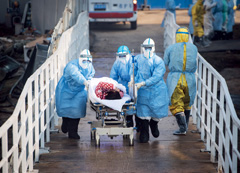
Medical workers at Huoshenshan Hospital transport a patient on February 4, the day the flash-built emergency hospital in Wuhan began admitting COVID-19 patients.
SHOULDER TO SHOULDER AT A SPECIAL MOMENT
Cambodian Prime Minister Hun Sen's extraordinary visit to China
By Wang Fengjuan
Cambodian Prime Minister Samdech Techo Hun Sen landed at Beijing Capital International Airport on February 5. The Cambodian prime minister's visit to China so soon after the novel coronavirus pneumonia outbreak attracted the attention of the international community. The Cambodian government has closely followed the development of the outbreak and repeatedly stressed that it would not evacuate Cambodian nationals, including students and diplomats, from China nor suspend scheduled flights between the two countries.
While visiting the Republic of Korea (ROK), Prime Minister Hun Sen suggested leading his delegation to Wuhan to lift the spirits of the Cambodian students there, if the Chinese government would allow it. Chinese leaders were a bit apprehensive about sending a top government official to the epicenter of the outbreak, so Hun Sen suggested visiting Beijing instead.
Prime Minister Hun Sen was still the first foreign government leader to visit China since the disease broke out. His visit attracted the attention of the general public in both China and Cambodia.
A Friend Indeed
On the afternoon of February 5, Chinese President Xi Jinping and Premier Li Keqiang held separate meetings with Prime Minister Hun Sen at the Great Hall of the People in Beijing.
Noting that China is currently doing everything it can to fight the epidemic, President Xi declared, “A friend in need is a friend indeed. The Cambodian people are standing with the Chinese people at this special moment. King Norodom Sihamoni and Queen Mother Norodom Monineath Sihanouk have offered sympathy and support. Prime Minister Hun Sen not only defended China's efforts on multiple occasions but is now visiting China. This testifies to the unbreakable friendship and deep trust between the two countries. It also demonstrates our solidarity through thick and thin, a defining feature of the China-Cambodia community with a shared future. China deeply appreciates Cambodia's friendship and support.” Xi added that China has the confidence, determination and capability to overcome the epidemic.
“China will work closely with Cambodia and other countries in the spirit of openness and transparency to respond collectively and effectively to the epidemic and uphold public health security in the region and beyond,” said Xi.
Hun Sen said that his snap decision to visit China was solely to demonstrate the strong support of the Cambodian government and people for the Chinese government and people. In this trying time for China, the Cambodian people continue to stand firmly with the Chinese people to withstand the difficulties together, just as any true friend would do.
“Some countries have taken restrictive measures that don't help and are not warranted by the epidemic,” Hun Sen noted. “The only thing scarier than the epidemic is panic.” He emphasized that Cambodia would continue its regular cooperation and exchange with China and remain committed to working with China on building a Cambodia-China community with a shared future.
During his meeting with Hun Sen, Premier Li Keqiang stressed that the people's safety and health always come first. China considers epidemic prevention and control its most important task at present, and the country is striving to guarantee supplies of key medical materials and daily necessities to safeguard normal life for all people in China, including Cambodian citizens and other foreign nationals.
On behalf of the Cambodian government and people, Hun Sen expressed sympathy for people affected by the epidemic. He also expressed appreciation for the Chinese government's care for Cambodian citizens, including students, in China. “We will stand firmly with the Chinese government and people to eliminate panic and overcome difficulties together,” he stressed.
In an interview with China Report ASEAN, Senate of Cambodia Advisor Chea Munyrith noted that Cambodia and China are comprehensive strategic partners and that Cambodia-China friendship is deep-rooted in the hearts of the people. “No virus can infect this friendship,” he declared. “The purpose of Prime Minister Hun Sen's visit is to bring greetings from the Cambodian people to our Chinese friends and showcase the true friendship between those who work together to overcome challenges and difficulties.”
In an interview on February 2, Chinese Ambassador to Cambodia Wang Wentian quoted an ancient Chinese saying: “True friendship stands out in times of adversity.” He commended Cambodia as “a friend indeed” which has stood together with China through thick and thin.
‘Upstream’ Foreign Leader
After the outbreak of the novel coronavirus, the international community responded with great concern, and some countries took restrictive measures. Prime Minister Hun Sen spoke highly of China's efforts to control the epidemic on many occasions and became the first foreign leader to visit China since the outbreak. His move in the “opposite direction of the usual one” serves as a testament that Cambodian people share good times and bad with the Chinese people.
At a daily press briefing, Chinese Foreign Ministry Spokesperson Hua Chunying was asked why the Cambodian Prime Minister was not going to see the Cambodian students in Wuhan. “We fully understand that Prime Minister Hun Sen cares deeply for the Cambodian students in China,” she explained. “Considering that Wuhan is on a tight schedule, doing everything it can to fight the outbreak, a huge visit to Wuhan at this moment would be nearly impossible to arrange. China attaches great importance to the health and security of Cambodian students in China. We will do our best to care for them like our own and ensure they have all they need during their stay in China.”
A Cambodian Foreign Ministry official described the visit as one to show solidarity with the Chinese people.
“I would like to inform my colleagues that I will arrive in Beijing on the afternoon of February 5 for a working visit before returning to Cambodia tonight,” wrote Hun Sen on social media to caption a picture of him boarding the plane.
Chea Munyrith has followed Cambodia-China cooperation for a long time. He noted that “upstream” has become a popular term in Chinese social media recently. When dangerous disasters emerge, members of the Communist Party of China are always among the first to respond. “Videos of heroic medical workers taking battle positions moved me to tears,” he said.
“Upstream Chinese heroes are fighting the epidemic on the front lines,” continued Chea. “Likewise, Prime Minister Hun Sen's “upstream” visit to China at this time is a show of solidarity that will boost the confidence of the people of both countries to win the battle.”
Boosting Confidence
Gu Jiayun, vice dean of the School of Asian and African Studies and director of the Cambodia Research Center at Beijing Foreign Studies University, revealed that when the first imported coronavirus infection was confirmed in Cambodia, the country experienced a short period of panic. Prime Minister Hun Sen chose to visit China to alleviate social panic through his own actions. This move also represented the support of the Cambodian government and people for China's battle against the epidemic, highlighting the essence of the friendship between the two countries.
Nop Veasna, president of the Association of Cambodia Students in China, estimates that a total of 2,399 Cambodian undergraduate, graduate and post-graduate students are spread across 23 Chinese provinces. According to the Cambodian Ministry of Education, 89 Cambodian students are enrolled at seven higher-education institutions in Hubei Province. Twenty-three of the students are still in Wuhan, where they are monitored by university authorities and have not contracted the infection. The other 66 students returned to Cambodia in early January for the winter vocation.
“We have witnessed the Chinese government taking the strictest prevention and control measures to protect its people,” commented Nop Veasna. “More and more patients are recovering and getting discharged from hospitals, which has boosted the confidence of the general public.” He called Prime Minister Hun Sen's visit to China at this special time proof that Cambodia and China are good brothers and friends. At this critical moment, Cambodia is standing firmly with the Chinese government and the Chinese people.
“Although Prime Minister Hun Sen didn't make it to Wuhan to see the Cambodian students there, his visit is still encouraging for those who work, study and live in China,” remarked Gu Jiayun. “It was a great boost of confidence. It encouraged students to continue their studies even under such difficult conditions.”
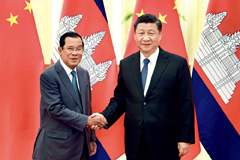
Chinese President Xi Jinping meets Cambodian Prime Minister Hun Sen at the Great Hall of the People in Beijing on February 5, 2020.
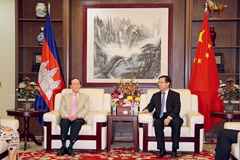
Chinese Ambassador to Cambodia Wang Wentian (right) meets Khmer-Chinese Association President Fang Qiaosheng to accept a donation of US$396,480 and 61,700 yuan made by 198 overseas Chinese in Cambodia to be used for virus prevention and control in China.
ASEAN Messages to China
Thailand
The world community is impressed by the efforts and determination of the Chinese government and all the measures undertaken by authorities to combat and contain the contagion which poses a real threat to all of us. Myself and the Thai people stand by the Chinese people and wish you success in overcoming this crisis, with the expectation that the situation will be restored to normal as quickly as possible.
—Thailand's King Maha Vajiralongkorn in a telegram sent to Chinese President Xi Jinping on January 31
Thailand and China share a close and special bond of friendship, and I have full confidence that China will overcome this situation and emerge stronger. I appreciate China's generosity towards the care of Thai people in Wuhan and other affected areas and confirmed Thai government's readiness in assisting China in any possible way to alleviate the situation.
—A letter from Thai Prime Minister Prayut Chan-o-cha to Chinese Premier Li Keqiang on January 31
Vietnam
Vietnam is enthusiastic about actively coordinating efforts with China to fight the new coronavirus epidemic. I sympathize with the losses and hardship that Chinese people are experiencing and hope that its vast experience in curbing the SARS epidemic in 2003 will help China successfully stop the new coronavirus soon.
—A note by Prime Minister Nguyen Xuan Phuc sent to Chinese Premier Li Keqiang on February 1
Laos
Since the outbreak of the epidemic, Chinese President Xi Jinping, also general secretary of the CPC Central Committee, has been leading and strengthening command personally and has set up a leading group of the CPC Central Committee on novel coronavirus prevention and control to cope with the epidemic comprehensively and swiftly. These measures protect the safety of the Chinese people as well as the safety of people around the world.
—A message from Lao President and General Secretary of the Lao People's Revolutionary Party Central Committee Bounnhang Vorachit to the International Department of the Communist Party of China (CPC) Central Committee on February 1
On behalf of the Party and government, the Lao people and on my own behalf, I would like to express my deep sympathy and condolences through Your Excellency to the brotherly Chinese Party, government and people, especially to the families whose loved ones have died.
—A message of sympathy from Prime Minister Thongloun Sisoulith to Li Keqiang on February 3
Myanmar
Under the able leadership of Mr. Xi Jinping and with the solidarity of the Chinese people and the country's advanced medical technology, the People's Republic of China will be able to successfully contain the outbreak of the epidemic and overcome difficulties in the shortest possible time.
—A message of sympathy from President of the Republic of the Union of Myanmar U Win Myint to Chinese President Xi Jinping on February 7
Brunei
On behalf of the government and people of Brunei, Sultan Hassanal Bolkiah supports the efforts of the Chinese government to deal with the outbreak of the coronavirus. Brunei welcomes efforts made by the Chinese government to contain the spread of the epidemic and restore the situation.
—A letter from the Sultan, Yang di-Pertuan and Prime Minister of Brunei to Chinese President Xi Jinping on February 7
Indonesia
Indonesia will always stand together with China through hard times, and Indonesia is ready to send assistance should China need any kind of necessary support to accelerate handling of the COVID-19 outbreak.
—President Joko Widodo in a phone conversation with Chinese President Xi Jinping on February 12
Malaysia
On behalf of the Malaysian government, I express my condolences to the Chinese government and people over their suffering as a result of the epidemic. Malaysia greatly appreciates the efforts and progress China has made to deal with the contagion, which I consider part of China's contribution to maintaining global public security as a responsible country.
—A phone call by former Prime Minister of Malaysia Mahathir Mohamad to Chinese President Xi Jinping on February 12
Philippines
I want to express strong solidarity with the Chinese president, Chinese government and Chinese people. China has been kind to the Philippines, and the Philippines can only return the favor.
—A letter from President Rodrigo Duterte to Chinese President Xi Jinping on February 16
Singapore
During this difficult period, Singapore stands in solidarity with China, and supports China's efforts to combat COVID-19. I hope our modest contributions brought some comfort and relief to those affected by the virus.
—A letter from President Halimah Yacob to Chinese President Xi Jinping on February 24
We saw how speedily China has mobilized to contain the spread and implemented practical measures to help people affected by the outbreak both in Wuhan and throughout China. We applaud China's firm and decisive response, and we are happy to see early indications the outbreak is starting to get under control.
—A letter from Prime Minister Lee Hsien Loong to Chinese President Xi Jinping on February 24
SAVING LIVES
Health workers fight a deadly virus
When the novel coronavirus (COVID-19) broke out, Chinese health workers were called to attention and started working overtime at their posts to save lives. It's hard to tell much about the person behind goggles and a mask, but it's clear who they are fighting for.
Whistle-blowers
When the new virus first struck, the general public did not know much about it. On the morning of December 26, 2019, Zhang Jixian, director of the Department of Respiratory Medicine at Hubei Provincial Hospital of Integrated Chinese and Western Medicine, treated an elderly couple from a neighborhood near the hospital who were suffering from fever and cough, symptoms typical of a flu. However, CT images of their chests looked quite different from others’.
Upon learning that their son had been caring for the couple, Zhang ordered a CT scan for him as well, which showed that his lungs were also infected despite not showing any symptoms. At that point, she realized a major issue could be emerging.
That same day, a businessman from a local seafood market suffering from fever and cough was examined with the same unusual results. What was the disease? Symptom-related examinations ruled out infection of influenza A and B, syncytial virus, adenovirus, rhinovirus, chlamydia and mycoplasma. Zhang became even more worried about the issue.
On December 27, she reported her findings to hospital authorities including Vice President Xia Wenguang and the Medical Department. The hospital reported the situation to Jianghan District Disease Control Center of Wuhan City.
Over the following two days, the hospital admitted three more patients who had visited the same seafood market. “Within four days, we had seven patients with the same unusual symptoms,” commented Zhang, who was aware of the possibility of a public health emergency after her experience fighting Severe Acute Respiratory Syndrome (SARS) in 2003. Having been informed of the situation, Vice President Xia organized interdisciplinary consultations before making the decision to report the situation to municipal and provincial health commissions.
In her department of respiratory medicine, Zhang designated an isolation ward and told staff to protect themselves according to relevant procedures. She forbade medical equipment in the isolation ward being used for other purposes and asked that medical waste from the ward be disposed separately.
A particularly brave warrior in the battle against the epidemic was Li Wenliang, an ophthalmologist at Wuhan Central Hospital.
On December 30, 2019, one of Li's colleagues informed him that test results showed that some patients had been infected with a “SARS-like” virus. At 5 p.m. that day, Li posted a message in a WeChat group including 150 schoolmates describing that seven people from the seafood market had been diagnosed with a “SARS-like” virus and isolated in his hospital. A screenshot of this post spread like wildfire, earning Li the reputation of “a whistle-blower.”
On January 7-8, 2020, Li treated a patient with acute glaucoma who was later a confirmed case of COVID-19. On January 10, Li himself developed symptoms such as cough and fever. On January 12, he was hospitalized and confirmed to be infected. Bedridden, Li soon found difficulty breathing and moving. “I will cooperate with treatment and try to recover soon and get back to work,” he said on social media.
On February 5, Li was admitted into the ICU with worsening conditions. Just after midnight on February 7, Wuhan Central Hospital posted a message on Weibo that Dr. Li was in critical condition and that resuscitation attempts were ongoing. A miracle never came, and Li Wenliang was declared dead at 3 a.m.
Li Wenliang regrettably fell in battle while Zhang Jixian continues fighting at Ground Zero as leader of her hospital's task force. She is still working day and night in the isolation ward and emergency department.
Racing the Virus
“Avoid going to Wuhan if you can!” advised SARS hero Zhong Nanshan, an 84-year-old academician at the Chinese Academy of Engineering, director of the National Respiratory Diseases Clinical Medicine Research Center and a prominent Chinese expert in respiratory diseases. Ignoring his own advice, Zhong jumped on an “upstream” train on January 18 to venture to the front lines in Wuhan. “The city has transformed into the battlefield against the epidemic,” he gasped. “As a doctor, I'm duty-bound to fight on the front lines.” At the critical moment, he was appointed leader of the senior experts' group of the National Health Commission. In 2003, he won public support not only due to his performance in treating severe cases, but also for his courage to tell the truth.
Seventeen years later, Zhong returned to the spotlight to reassure the general public. He led his experts' team to investigate the situation on the ground and devised plans for prevention and control. His tight schedule also included teleconsultation, news conferences, interviews and many other activities. Despite exhaustion, he remained confident in his straightforward judgment, which assured the public that victory would be seized soon.
Zhang Ningyu, president of Jinyintan Hospital, Wuhan's largest specialist infectious disease hospital, had some difficulties rushing to the front lines. In 2018, he was diagnosed with amyotrophic lateral sclerosis (ALS). “I don't have much time left,” he revealed to colleagues. “I have to keep going.” On December 29, 2019, his hospital was isolated and began treating the first seven “SARS-like” patients. Since then, they have continued treating other critical confirmed cases of COVID-19 infection.
“Please hurry!” he frequently begs into his phone. “Wasting time could mean people die.” On the evening of January 29, he made eight phone calls in an hour. After getting in bed at 2 a.m., he rose at 4 a.m. to answer emergency phone calls.
While Zhang was fighting to save lives of hundreds, his wife, also a doctor, was also working in isolation with COVID-19 patients in another hospital a dozen of kilometers away. Thinking about her made his eyes tear up.
Zhao Zhigang is deputy chief physician of the Emergency Department of Zhongnan Hospital of Wuhan University. After a fever of 38 degrees Celsius for three consecutive days in mid-January, he was diagnosed with minor COVID-19 infection. He applied for quarantine treatment at home. When his fever receded, he volunteered to join his hospital's online experts' group to offer consultation services through the hospital's official WeChat account. Zhao explained that most patients he consulted online were suffering minor or atypical symptoms. Around 10 percent of patients were residents of other provinces and regions. He offered them treatment advice and suggested ways of coping with emotional stress.
Since the illness emerged, Hubei Province and Wuhan have remained Ground Zero in battle. Health workers were among the first to respond. Despite great danger and intense stress and exhaustion, they never complained or backed down. In the isolation ward, they were protected by layers of protective gear including face masks and goggles that left deep impressions on their faces after hours of hard work. For many days, medical protective gear was in short supply. To save supplies and time, adult diapers became part of the gear. When they became exhausted, they slept for a few minutes on the floor in the gear. Despite worries about their families, they couldn't make a call during work hours... Behind the white protective gear stood dedicated professional doctors and nurses.
Racing the Clock
The outbreak of the epidemic has tremendously impacted everyone in the country. As confirmed cases increased, so did sickbeds in designated medical institutions. Two emergency hospitals, Huoshenshan and Leishenshan, were built incredibly fast. Sports stadiums, exhibition centers and warehouses were converted into quarantine hospitals. Several regular hospitals were modified into quarantine hospitals.
Local health workers were overwhelmed by the workload. Hubei asked for emergency assistance from other provinces and regions.
In response, health workers began streaming into Hubei from all over the country. By February 6, nearly 100 national, provincial, municipal and military medical teams with a total of 9,277 professionals had arrived in Wuhan. Fifty-six of the medical teams with 5,540 members were assigned to the city's specialist hospitals. Four military medical teams with 1,400 members were assigned to Huoshenshan Hospital. Thirty-nine medical teams with 2,337 members were assigned to three quarantine hospitals as nine medical teams with 1,400 members were still en route to the city.
They rushed to battle from all over the country. Among the health workers were both veteran doctors and fresh faces. The sudden outbreak changed the trajectory of their lives, who didn't have a chance to bid farewell to loved ones before leaving.
Wang Yani is a nurse at Longde County Hospital in Ningxia Hui Autonomous Region in northwest China. She was already on her way to the airport when her family learned from social media that she had volunteered to go to Wuhan. “I didn't inform you all earlier because I didn't want you to be worried,” she explained when her brother called.
“Take care of our parents,” she added.
Her mother looked particularly worried on a video call, but Wang assured her that she would be fine.
On the evening of January 24, New Year's Eve on the Chinese lunar calendar, 143 members of the PLA Air Force Medical University Medical Team boarded an “upstream” special plane bound for Wuhan wearing combat fatigues. Among the passengers were head nurse Zhong Yuexia and her husband Wang Xin, a specialist in digestive diseases. Zhong brought the experience of performing a dozen major operations to treat infectious diseases including SARS and Ebola. She volunteered to join her university's medical team, leaving her husband behind with her family. But when Wang learned that some COVID-19 patients were experiencing complications with digestive diseases, he also volunteered to join the team. Hospital authorities were hesitant about placing them both in the same emergency response team, but Wang was firm about his desire to join the battle. Despite becoming members of the same team, Zhong and Wang still couldn't see each other much. “We have confidence to win this battle by standing together,” they insisted.
Li Ran is a doctor at People's Hospital of Peking University. At 9 p.m. on February 8, medical teams from the People's Hospital and the Third Hospital of Peking University took over the renovated isolation ward of Wuhan Tongji Hospital to treat severe cases.
“As soon as I put on the protective gear, the first patient was pushed into the ward on a bed,” recalled Li. “More patients were already waiting to be hospitalized. There's always so much to do with patients in such critical condition, so I couldn't even start to think about a break.”
“After a tense shift, I felt a severe headache and more exhaustion and dehydration than I had ever felt before,” reported Li. The lack of oxygen under layers of protective gear was even worse than working in Lhasa, Tibet, more than 3,000 meters above sea level. But when he noticed that the first patient had increased his blood oxygen saturation to 90 percent and was breathing smoothly, he felt all the pain paying off.
Members of the medical teams have overcome major difficulties by working professionally. A six-hour shift usually stretches to 10 hours due to briefing, debriefing and protective procedures. The work in the isolation ward in protective gear is more energy-consuming. To save time and protective gear, health workers can't stop to eat or drink. To reduce risk of infection, most female workers on the front lines hacked off their hair. Health workers have transformed into special forces in the heat of battle.
By February 14, a total of 7,039 patients had recovered and were discharged from hospitals in China. Each number represents a life saved, which fosters hope and confidence for health workers to win the battle.

A doctor behind foggy protective goggles in an ICU isolation ward of the First Affiliated Hospital of Nanchang University in Jiangxi Province.
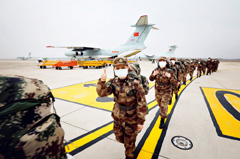
Eight PLA Air Force transport aircraft carrying 795 military health workers and 58 tons of relief materials from Shenyang, Lanzhou, Guangzhou and Nanjing land at Wuhan Tianhe Airport on February 2.
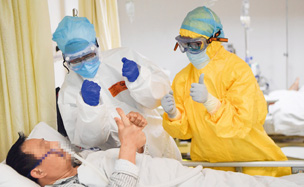
Health workers attempt to cheer up a patient in an isolation ward of the intensive care unit (ICU) at Chongqing Three Gorges Central Hospital on February 1.

Bai Hui, Li Chunfang, Zhao Zhigang and Guo Qin (left to right), doctors and nurses who have recovered from COVID-19 infection, return to work at the emergency center of Zhongnan Hospital of Wuhan University on February 6.

By February 6, nearly 100national, provincial, municipal and military medical teams with a total of 9,277professionals had arrived in Wuhan. Fifty-six of the medical teams with 5,540members were assigned to the city's specialist hospitals. Four military medical teams with 1,400members were assigned to Huoshenshan Hospital. Thirty-nine medical teams with 2,337members were assigned to three quarantine hospitals as nine medical teams with 1,400members were still en route to the city.
CONSTRUCTION HEROES
A race against time to complete Huoshenshan Hospital in Wuhan

Medical workers transport a patient at Huoshenshan Hospital, a specialist facility built in Wuhan amid the epidemic, on February 4.
After the novel coronavirus (COVID-19) pneumonia broke out in Wuhan, a city of 11 million in central China's Hubei Province, hospitals across the city were soon packed with patients and began struggling with a persistent shortage of medical supplies. On January 23, the municipal government decided to build an emergency hospital on the outskirts of Wuhan to help relieve pressure on the city's overburdened healthcare system.
Completed at a record speed, Huoshenshan Hospital began admitting COVID-19 patients at 9 a.m. on February 4 after it was handed over to medical teams of the Chinese army, creating a new ray of hope for epidemic prevention and control in Wuhan. The complex was modeled after Beijing's Xiaotangshan Hospital, a facility built in 2003 during the Severe Acute Respiratory Syndrome (SARS) outbreak.
Fully equipped with intensive care units and isolated wards for infectious respiratory disease, Huoshenshan Hospital covers an area of more than 30,000 square meters and consists of nearly 2,000 prefabricated units. A project like this built on lotus pond would normally take at least two years to complete with standard construction procedures. Even a temporary facility of this size would typically take a month to build in an emergency. However, four Chinese construction companies, China State Construction Engineering Corporation (CSCEC), Wuhan Construction Engineering Group, Airport Development Group of Wuhan and Hanyang Municipal Construction Group, managed to erect Huoshenshan Hospital in just 10 days.
When an epidemic breaks out, a command is issued. As millions became desperate to escape the deadly disease, brave construction workers set off marching upstream toward Ground Zero of the epidemic.
All-out Mobilization
At 5 p.m. on January 23, China Construction Third Engineering Bureau under CSCEC convened a pre-construction meeting to mobilize all resources available in the shortest amount of time.
In April 2003, China Construction First Building Group Corporation Limited, another CSCEC subsidiary, completed Xiaotangshan Hospital in just seven days. “I never expected to use the blueprint for Xiaotangshan again,” sighed Dr. Huang Xiqiu, a renowned architect who designed the emergency hospital built in Beijing 17 years ago to treat SARS patients. He served as head of the technical expert team for the Houshenshan project. When Wuhan asked for help around 2 p.m. on January 23, Dr. Huang and his team delivered an improved architectural plan barely an hour later.
Wang Jingwen is a 26-year-old designer with the Second Construction Co., Ltd. of China Construction Third Engineering Bureau. After learning of the Huoshenshan project, she dropped her Spring Festival plans of visiting her hometown with her boyfriend. Instead, she arrived at the construction site on the first day of the Lunar New Year and offered to develop a detailed design document while providing technical support to the construction team.
Huang Tian is Wang's colleague. An experienced technician in design development, he drew up a more detailed blueprint for construction of inpatient building No. 2 while also providing field engineering support. To ensure accurate alignment of prefabricated units and precise door, window and wall panel sizes, he took more than 23,000 steps each day around the project site. Just married, his honeymoon was canceled in favor of the project, and he also spent his birthday at the construction site. “I felt guilty about making my family worry about me,” Huang admitted. “But in the face of such crisis, I feel obligated to do my part to help the city endure these dark days.”
Luo Wenhao, a 31-year-old native of Wuhan, was among the first to volunteer for the construction team. His company, China Construction Industrial & Energy Engineering Group (CCIEE) under CSCEC, handled installation of electromechanical equipment and outdoor civil engineering. If not for the epidemic, Luo would have stayed at home with his wife who was about to give birth. “I have a very supportive family—especially my wife,” he noted. “Whenever I am free, I text her to ask about her health and reassure her that I'm good here.” Luo decided to name his baby “Yuanhan” (helping Wuhan) to commemorate the moment.
To meet the desperate need of manpower, Su Hong, a 53-year-old foreman at CCIEE, summoned a large group of workers from the areas surrounding Wuhan. The CCIEE took immediate action to provide a recruitment document for the workers so they could enter the locked-down city. “At first I was worried I wouldn't be able to recruit enough workers,” Su recalled. “I was moved by the enthusiastic response from my men. They quickly prepared to travel to the project site.”
Su's team was primarily responsible for laying sewage pipes. “Hurry up!” Su urged as the 1 a.m. hour approached. “This prefab room must be delivered tomorrow. Over 300 workers joined us today, and I need to put them in position as quickly as possible.” Su's son is also a construction worker and was then working around the clock to build an emergency hospital in a neighboring province. During breaks, the father and son would send WeChat massages to each other.
On January 24, the day after the decision to build Huoshenshan Hospital was made, five rollers, 33 bulldozers, 95 excavators and 160 dump trucks joined the project. Around 160 site managers and 240 workers were assembled, and a reserve team of 2,000 workers was formed. That night marked the eve of Chinese New Year, an occasion usually reserved for family reunions, but the entire construction site was brightly lit as machines roared.
“I've never seen this kind of mobilization in my life,” declared World Health Organization Director-general Tedros Adhanom Ghebreyesus at a press conference in Geneva on January 31. “And maybe you're following the hospital built in 10 days, big hospital, but that's not the only thing. You know the measures they are taking—I believe they will reverse the tide.”
Incredible Speed
“Construction of Huoshenshan Hospital is a battle against extremely limited time and space,” illustrated a head of project command. “We must carefully use every effort to win.”
Thousands of builders from across China worked day and night to complete the hospital in just 10 days, demonstrating the incredible speed of China in constructing monumental projects. At construction peak, more than 7,000 workers and 800 machines were working at the site. When one team finished sanding the ground, the next was ready to lay impermeable film, and another at their heels to perform footing engineering. The high density of personnel and machinery resulted in limited operating space.
From overall layout to sewage pipes, every aspect of the project had to meet the highest standards to ensure perfect functionality and safety of a hospital dedicated to treating an infectious disease. When each procedure was completed, the workers would carry out an inspection followed by a double check conducted by the foreman and engineering technician within an hour.
Gu Jianbing is executive director of the CCIEE Beijing Branch. On his first day in Wuhan, he headed directly to the project site of Leishenshan Hospital, another emergency hospital under construction, and presided over a meeting on task arrangement until 2:00 a.m. He returned early the next morning to discuss construction plans with multiple partners and then hurried to the Huoshenshan site after a quick lunch. “The trumpet for battle has sounded, and all I can do is march forward,” illustrated Gu with bloodshot eyes and a stubble-covered face.
“Hurry! Hurry up!” begged Ye Hun, head of the power engineering branch of Wuhan Caidian District Power Supply Company under State Grid Hubei Electric Power, to his team responsible for cable and box-type substation installation. While laying cables, he kept a close eye on the site and worked with other civil engineering construction teams night after night. The temperature usually dropped below zero late at night. When exhausted, Ye would take a quick nap in a construction vehicle. He often woke up to some loud noise and returned to his post.
Mission Impossible
Construction of Huoshenshan Hospital attracted worldwide attention. The project amazed many foreigners after they watched online videos capturing the remarkable progress.
As construction workers and machinery raced against time to complete the hospital, “incredible” and “stay strong China” became trending topics on social media platforms. “The whole country has been mobilized—only China could do this!” a foreign netizen exclaimed. Myanmar netizens also praised the Chinese government and people for their solidarity and all-out efforts to fight the disease.
Seventeen years have passed since the SARS outbreak, and China's infrastructure and building abilities have significantly improved. China Construction Third Engineering Bureau has built dozens of skyscrapers above 300 meters. As the Huoshenshan project coordinator, the company managed to mobilize labor, machinery and other resources to start construction work overnight. It also provided effective coordination at the construction site. As the project advanced, the number of site managers increased from 160 to nearly 1,000, workers from 240 to 4,200, and machinery from 300 pieces to about 1,000. On-site operations were carried out in shifts to ensure around-the-clock construction.
“We ensured highly-efficient joint operations,” commented Deng Weihua, site commander of the Huoshenshan project. “A three-level command system was quickly established to incorporate Wuhan Urban and Rural Construction Bureau, China Construction Third Engineering Bureau and subcontractors. All participants cooperated for a common goal.”
Builders and machines all played key roles in driving the project forward and providing hope for patients suffering from the epidemic as well as the rest of the country. Seamless coordination among subcontractors and municipal engineering firms helped ensure a fast construction time. Their concerted efforts resulted in high-voltage power lines and gas pipelines connected to urban networks within 24 hours.
The Huoshenshan project broke ground on January 23. Excavators began rolling in on January 24 and construction of the hospital was officially launched on January 25. Notable progress was achieved with each passing day: The first standard prefab room was built on January 26, land leveling and backfilling were completed and the first group of modular units started hoisting on January 27, and the steel structure of a two-story ward building took shape on January 28. Installation of medical devices began on February 1, and the entire facility was delivered to medical teams the following day. The hospital was set up in just 10 days thanks to thousands of construction workers who stayed focused day and night.
Livestreams provided by China Central Television enabled anyone to “supervise” construction of Huoshenshan Hospital in real-time, and they became surprisingly popular. More than 40 million people from China and around the world watched the live broadcast. More than livestreaming a grand project, the cameras captured hope in the fight against the epidemic.

Workers busy at the construction site of Huoshenshan Hospital on February 1.
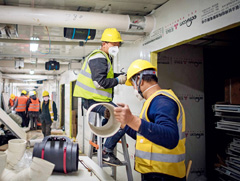
Workers from China Construction Third Engineering Bureau busy at the construction site of Huoshenshan Hospital on February 1.
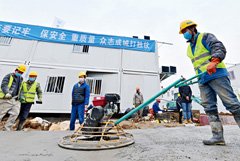
Workers finish off construction of Huoshenshan Hospital on February 2.
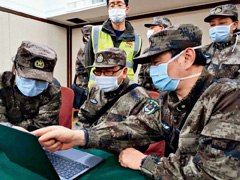
Mao Qing (right), an expert with a medical team from the Chinese army, works on protective measures in wards of Huoshenshan Hospital on February 5.

A panoramic view of the construction site of Huoshenshan Hospital on January 31.
PLAYING HEARTSTRINGS
Little acts of kindness shine like rays of sun in the fight against the epidemic
Some say that acts in special circumstances reveal the true colors of a person. Since the coronavirus broke out in China, many have done everything they can to protect themselves and their loved ones, while countless others have stood up to help others. Even people who don't have much have shaken the world through their kindness to others.
Needed Face Masks
Face masks became a crucial item for most Chinese people after they quickly sold out in drug stores and supermarkets. A young man named Hao Jin, born in the 1990s, donated 18,000 face masks. He once worked at a failing face mask factory that started paying employees in masks when the money ran out. Hao had held onto masks worth 20,000 yuan (US$2,847.6). When he learned that no one could buy face masks, Hao decided to donate all the masks he had been keeping.
When the head of the village where Hao Jin lives asked to compensate him, Hao refused. “I don't want a single penny,” he declared. “I don't want to profit off my country's difficulties!”
When overseas Chinese around the world learned that various medical supplies were in short supply in China, they used collected donations to buy face masks and other medical supplies locally before shipping them to China.
On February 3, flight CZ634 from Kenya to Guangzhou, capital of Guangdong Province, was loaded with thousands of boxes of N95 face masks, surgical masks, medical gloves and protective clothing instead of passengers. After the boxes landed in China, they were immediately transported to Central China's Hubei Province and other places.
Overseas Chinese living in Southeast Asian countries also sent medical supplies to China. On January 28, Wang Quancheng, president of the Huayuan Association, a non-profit organization serving a new-generation of Chinese immigrants in Singapore, canceled his business trips and withdrew cash to buy all the face masks he could find and contact manufacturers, customs, airlines and government agencies to determine the fastest “Green Passage” to China.
On January 30, the first shipment of supplies was sent from Singapore Changi Airport to Xiamen in China's Fujian Province. The second shipment lifted off on February 1. The third caught the last flight on the afternoon of February 3.
Because Singapore suspended flights to China, Wang Quancheng decided to buy supplies from South Korea, Japan, Russia and Indonesia and ship them to China.
In Thailand, head of “Buyer Association” for g.taobao.com, an overseas commodity trading platform, not only scoured local factories looking for face masks, but also searched every convenience and drug store. He gathered 300,000 face masks and 3,000 sets of medical protective clothing, which were all sent from Bangkok to China's Zhejiang Province by air.
Another buyer in Thailand associated with g.taobao.com amassed a huge stash of medical supplies. When some tried to buy from him, he refused without hesitation and insisted that the supplies were to be donated.
Brave Delivery
Wang Yong, a native of Wuhan at the epicenter of the coronavirus outbreak, works as a courier. On January 24, the eve of Chinese New Year, he saw a WeChat post from a hospital nurse. “Help! I cannot get home now because public transportation is not allowed to come here,” she explained. “If I walk, it will take four hours.” No driver dared pick up the nurse either. Wang Yong strapped on a face mask and headed to the hospital without telling anyone the plan.
“I didn't think that someone would answer my request,” the nurse gasped. She sobbed the entire trip home.
That day, Wang Yong shuttled nearly 30 medical workers to and from the Wuhan hospital. “I was also afraid of getting infected, but seeing medical staff begging for help on the internet, I changed my mind,” he admitted.
Since that day, Wang Yong has been living alone in the company warehouse. He drives medical staff to and from work every day and set up a WeChat group, calling for more volunteers to join in. Wang and other volunteers also contacted bike rental service providers to place more bicycles near hospitals and hotels to help solve the problem for those who needed to travel a shorter distance.
“I don't have many resources, but I do what I can,” Wang asserted. “I am glad to see so many volunteers helping out.” He explained that driving medical staff saves them four hours daily, or 400 hours for 100 persons. “How many lives can they save with that extra time? Our efforts are worth it,” he smiled.
During lunch hour on the eve of Chinese New Year, doctors from the Pneumology Department of Shanghai General Hospital ordered food delivery with the note: “I can pick up the food from the road, so you don't need to come upstairs.” About 30 minutes later, a courier scaled the hospital stairs carrying extra dishes and a note reading: “You work so hard as doctors, so we added some free dishes. Happy New Year!”
Small Acts
Village head Wang Guohui in Shenqiu County, Henan Province, woke up every villager on the early morning of January 24. Wang and more than 20 villagers collected a total of five tons of vegetables including over 2,500 kilograms of green vegetables and 2,050 kilograms of wax gourds. Then Wang set off alone to donate the vegetables to the construction site of Huoshenshan Hospital in Wuhan. He arrived the destination around 8 p.m.
A small village of 93 permanent households in Hekou Yao Autonomous County, Yunnan Province, donated 22 tons of bananas in less than two days. A motorcycle team carried the bananas from the village to Huangshi City, Hubei Province.
More than 400 medical workers from Beijing and Shanghai stayed at the Wuhan Marriott Drow Hotel. On January 27, a farmer driving tricycle tractor loaded with 24 boxes of vegetables arrived at the hotel. “I heard medical teams stay here, so I brought some fresh vegetables,” he said. The farmer refused any compensation when hotel staff attempted to pay him.
This generous farmer traveled 40 kilometers to deliver vegetables. He didn't know the roads or how to use mobile navigation. Along the way, he constantly asked for directions as the wind battered his face and hands. “The vegetables are very fresh,” he beamed to the hotel staff. The load could have fetched a good price, but he saved the best for the medical team.
Construction of Huoshenshan Hospital in Wuhan attracted major public attention. When a furniture store operator surnamed Yuan in Luoyang, Henan Province, received a 200,000 yuan (US$28,475) order for medical cabinets, he arranged transportation immediately and notified the buyer: “Payment is not necessary. We are donating the cabinets free of charge.”
But Yuan didn't have everything for the order in stock, so he asked peers for help. A group of 14 furniture stores prepared all the medical cabinets for the order in one night. After loading them on a truck, the logistics company realized that the goods were bound for Huoshenshan Hospital. They too refused any compensation and guaranteed the shipment would be delivered the same day.
Regardless of the impact of epidemic on business, many small business owners have refused any compensation now that profits don't seem like a priority.
This handful of stories provide only a tiny glimpse at the countless ordinary people who have made huge sacrifices to support the areas needing the most help. Such little acts of kindness add up to produce huge warmth to light the road ahead.
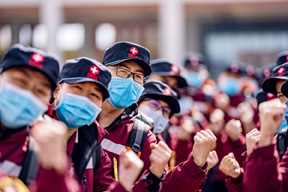
A medical team from Yunnan Province bound for Xianning City, Hubei Province, prepares to set off on February 12.

An airport worker unloads a shipment of medical supplies from France in Wenzhou, Zhejiang Province, on February 9.

On February 12, volunteers and villagers from Xidu Town, Hunan Province, load vegetables onto a truck bound for Hubei Province.
WAITING IT OUT IN WUHAN
Citizens stuck in locked-down Wuhan manage to carry on
By Zhang Lulu, Yang Xi, Qin Qi
Turn back the clock to 10 a.m. on January 23 for a moment. The Wuhan Coronavirus Prevention and Control Command Office announces that all buses, subways, ferries and long-distance coaches in Wuhan, the capital of Hubei Province, have been suspended, and outbound channels at airports and railway stations are also closed. Jianghan Road Pedestrian Street, normally a bustling place, looks like a ghost town. The streets are empty as are public squares, as if Wuhan has been frozen in time.
Since that moment, national attention has been focused on the city of Wuhan. Some claims such as “Five million people escaped Wuhan before the lockdown” and phrases like “Why us?” went viral on the internet. The pressure on the city has risen as the number of confirmed cases has increased.
Through video blogs and diaries written by Wuhan natives, we can get a glimpse of the isolated lives of ordinary residents since the lockdown started, but such anecdotes cannot capture the whole story and do not represent all of the 9 million people in Wuhan.
So how is the life for healthy people in Wuhan? Has daily life been unfolding smoothly? How did they feel about the storm of public opinion that swept through the city? What do they care about?
Too Risky to Take
Wuhan springs are warm, and flowers gradually bloom pink pedals in residential communities throughout the city. Mr. Xing, a resident of one community, was in no mood to enjoy the flowers. He dropped his trash bag in a public dustbin and hurried upstairs. When he got home, Mr. Xing removed his hat, goggles, gloves and mask. Then he changed his coat, washed his hands carefully, sprayed the clothes with disinfectant and threw them in the clothes hamper.
A month has passed since Wuhan was put under lockdown to prevent the spread of the novel coronavirus. Mr. Xing has strictly followed his intricate process to protect himself every time he leaves the house, even if it's only to toss out a bag of trash.
For those lucky enough to have stayed healthy, they still sacrificed time, opportunities, and long-held traditions for the greater good.
He Guangming was as happy as ever when his first grandson was born. The whole family was overjoyed, with both the baby and the mother perfectly healthy. But even though they are all living under the same roof, He did not often go into the nursery room. They could not afford any risks.
He and his wife came to Wuhan in mid-January, just before the baby was born. Soon after their arrival, news came of the novel coronavirus outbreak, and on January 23, the city was placed in total lockdown.
The city's 9 million residents, not to mention people like He who were there for one special occasion or another, have stayed and endured countless adversities.
A month has passed. While many continue to cope with the outbreak, isolation, and other hardships, some have found hope in small happiness—like He and his wife, who would wear thick masks and visit the new baby in the next room for a few seconds a day.
Canceling Spring Festival Celebrations
The novel coronavirus disease, known as COVID-19, has so far claimed the lives of more than 2,300 around the world, including 1,856 in Wuhan. Since the start of its lockdown, the only people authorized to move in and out of the city have been workers bringing in essential supplies, as well as nearly 40,000 doctors and nurses rushing from all over China to the frontline to save infected patients.
Meanwhile, ordinary people have stayed put in their homes, answering the call of the government to avoid going out and gathering into crowds.
To people in China, this was no small ask. The timing of the outbreak could not have been worse, occurring right before the Chinese New Year—also known as Spring Festival—which this year fell on January 25. On this most important of holidays, reuniting with families and relatives is beyond tradition.
This year, traditional family reunions to celebrate the Chinese New Year were forced to change. Instead of getting together with relatives and visiting friends, people consciously responded to the call of virus control and chose to stay home. Thankfully, the popularity of smart phones and ubiquity of WeChat, an instant messaging service, have enabled social life to continue. People use WeChat to greet each other and chat or drink together through a video livestream.
Visiting and spending time with extended families and relatives has been the way Qi Yang celebrated every Chinese New Year. Normally working in Wuhan, Qi left for home in neighboring Jingzhou City a day before the lockdown, planning to attend a family gathering of more than 20 people during the holiday.
Like families all over China, Qi's family canceled the plan after learning about the severity of the disease. Qi, along with his wife and son, stayed with his parents at home, making a simple dinner using what food materials they had to celebrate the Chinese New Year.
Tight Supplies
Daily necessities also became a practical issue for many families like Qi's, never thinking they needed to prepare for the long haul. Shopping for food and supplies became a challenge, especially in Wuhan, as supermarkets and grocery stores were places to avoid for the sake of minimizing people-to-people contact.
Instead, people relied on the community staff of their residential areas to help with their purchases. Orders are placed in WeChat groups, and the staff would inform residents of the arrivals of their meats and vegetables, which are often put down at the community entrances for people to pick up. As for the quality of the produce, nobody has the luxury to be picky.
Liu Yong, a Wuhan native and an associate professor at a local university, heard about some online grocery stores that offered an alternative to buying through community staff. She was hardly the only one, judging by the speed of things getting sold out. Liu had to act quickly and place orders right at 10 p.m., when new stock becomes available every day.
The prices were noticeably higher. Still, considering the situation, Liu said she did not feel like she has been ripped off, and she counts herself lucky whenever she was able to buy what she wanted from the online market.
One item has been particularly hard to come by—face masks. Everywhere in China, those who must venture out of their homes are wearing masks in the public. Few shops could keep a stock earlier during the outbreak, and people who bought them had to find ways to keep from running out.
Hunkering Down
Wang Bing, a Wuhan native who has a job in Shanghai, said he was fortunate to have friends from outside the province to send him some masks—a lot of people did not. He heard that some families have to share the one or two masks they had, and reuse them again and again. He said it reminded him of old stories of poor families sharing one pair of good pants, and whoever had to go out got to wear them.
Yet Wang wondered whether people in Wuhan right now might feel even more shackled than the people in those stories. He said he heard rumors of someone getting infected just by taking a walk downstairs, so he and his family have chosen to stay indoors as much as possible—even though they are allowed to move around within their community compound.
But if he and his wife can manage hunkering down for weeks, his five-year-old son is finding the boredom and isolation extremely difficult to deal with. Wang said his son had searched every corner of the home to find things to play with.
However great their anxieties, though, Wang said they could not compare to what the people infected by the virus are going through, which fortunately did not include any of his family members so far. Many who he grew up with were not so lucky, and Wang said he was especially troubled by the news that a friend and his wife both had the virus, one of whom might be beyond cure.
“It was simply too miserable.” Wang, preferring to use a pseudonym for the interview, said he could not yet bear reaching out for more updates or to ask about the couple's two young children.
Jobs and Futures
Wang has another reason to be restless at home. As a manager of a major courier service company in Shanghai, Wang has been working remotely and monitoring virus containment efforts throughout the country, and he is gravely concerned about his company and the thousands of people it employs.
Online shopping and express shipping have been integral parts of the daily life for people in China, even before they became immobile in their homes. With soaring demand, businesses like Wang's are now faced with the lifesaving yet labyrinthine local policies to combat the outbreak.
Wang said he understood the need for the stringent measures, but policies like the ones requiring recently traveling workers to be quarantined for 14 days—the suspected incubation period of the virus—has been burdensome, especially for the company-hired truck drivers who are always on the road.
The company is also having increased financial pressure, and measures tiding businesses over the crisis period are not helping—one policy encourages state-owned firms to reduce rent, but Wang's company leases from private developers. Looking at other companies with plans for mass layoffs, Wang said he wishes his own company will not have to face similar decisions.
As working professionals agonize over their jobs while enduring the prolonged fight against the novel coronavirus, young people still in school are worrying if their careers might be over before they begin.
Wang Zhuoting, a college student studying in Wuhan, returned to her hometown in nearby Tianmen City in mid-January. She is on the last year of her product design major, and she had been expecting to graduate in June and find a job.
To complete her degree, Wang still needs to finish a thesis and a design project. But with schools in Wuhan remaining closed for the foreseeable future, all Wang could do is wait. She could work on her thesis at home, but the design project requires machines, and she does not have access to a workshop anywhere. “If we can't begin this semester still, I'm afraid I'll be out of school forever,” Wang said.
The period between the end of Spring Festival and June is usually the job-hunting season for prospective graduates. As would be expected, opportunities are scarce in a city under total lockdown. Wang said her school had set up job fairs online, and she is also considering applying outside Hubei Province. Yet without assurances she would graduate in the first place, or that travel restrictions would be lifted any time soon, all to her seems little more than wishful thinking.
Silver Linings
At her university, Liu Yong and the teaching staff had been working to help graduating students stave off anxieties. Some had planned to start internships in late February, which had to be postponed. Liu suggested the students finish their graduation thesis and then wait to carry on the internship when all is better. “We only have to change our plans and wait till we have a way out.”
And some experts have said that waiting is an effective strategy against the outbreak. As more hospitals were built and patients underwent treatment, the number of new cases in Wuhan had declined from thousands a day to fewer than 400 on February 20. “I believe given time, the outbreak can be contained and resolved, definitely,” Liu said.
And while people in Wuhan hold their breath, some had found silver linings as they wait out the crisis. Wang Bing, whose work has taken him away from Wuhan and his family for years, said he has had a “personal transformation” while stuck in his hometown.
“I came to realize the importance of the entire family to be together,” he said. “In fact, nothing beats a whole family staying together, each of us healthy.”
Wang said he had thought about finding a job in Wuhan after the outbreak is over. “Family is the first priority,” he asserted.

A girl plays alone on the roadside in Wuhan, capital of Hubei Province, on February 23, a month after the city was locked down.
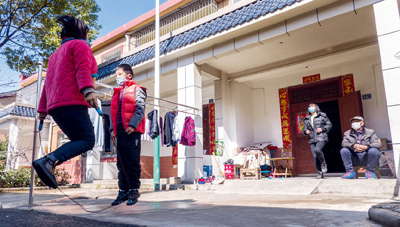
Two children skip rope in Xinmin Village, Wuhan, on February 16.
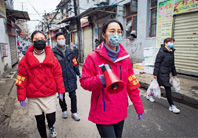
Weng Wenjing (front), Party secretary of Zhonghualu Street's Xichenghao Community in Wuhan, and two volunteers take to the street to promote coronavirus prevention and control measures on February 7.
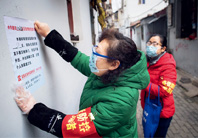
A social worker of Zhonghualu Street's Xichenghao Community in Wuhan posts coronavirus prevention tips on February 7.
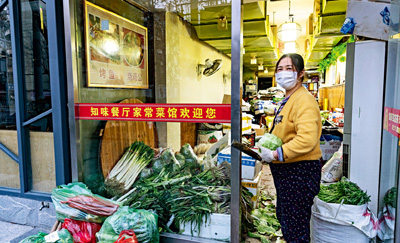
A woman arranges vegetables in her once-thriving restaurant that has been temporarily converted into a produce shop. Residents in Wuhan have been going out less since the epidemic broke out.
WAITING ON LATE SPRING
Chinese people navigate the COVID-19 outbreak

A girl passes through a security check at Sanya Phoenix International Airport in China's southern island province of Hainan on February 13. That day, a total of 112 passengers from Hubei Province who had been stranded in Sanya due to the outbreak flew back to Wuhan on a chartered flight.
A floating ash of an era can fall on a single person as a huge mountain. The sudden outbreak of the novel coronavirus (COVID-19) has disrupted the lives and work of almost all Chinese people, and every single one of them has become involved in the battle against the virus. As if freezing the world, it silenced city noises and heralded a long Spring Festival holiday without festivities.
The epidemic is changing society and people's attitudes towards life. Medical workers are racing against time to save patients, and citizens from every walk of life are making big contributions as every individual endeavors to go on living the best they can. Everyone is looking forward to spring to unfreeze the chilling scene.
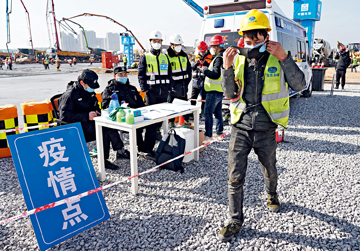
A construction worker puts on a mask he just received at a construction site for an emergency medical facility in Xi'an, capital of western China's Shaanxi Province, on February 3. The first phase of the facility, expected to be completed in 10 days, provides around 500 beds for quarantine wards. The total area of the facility is 33.33 hectares.
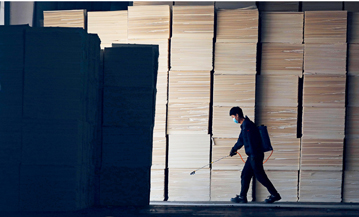
An employee disinfects his workplace in a paper factory in Jiaozuo, central China's Henan Province, on February 12. As more and more companies resumed production after February 10, measures including disinfecting the workplace and taking employees' temperature regularly, staggering meal periods and providing isolated dinner tables have been taken to prevent the virus from spreading.

Doctors and nurses dance with patients in a cabin hospital converted from a cultural building complex dubbed “Wuhan Livingroom” on February 10. Exercise helps recovery and mental health.

A young man reads a book in a cabin hospital transformed from Wuhan International Conference and Exhibition Center at the epicenter of the virus outbreak. The hospital began admitting patients with mild symptoms on February 5.
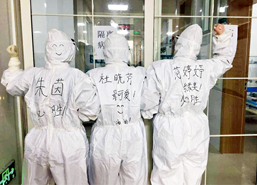
Medical workers in quarantine wards find some cheer by writing their names on their suits so they can be identified.

On February 16, a volunteer named Li Jian disinfects a residential area in Zhengzhou, Henan Province.
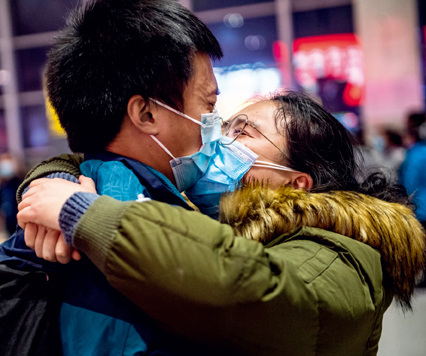
A medical worker from the medical team sent by southwestern China's Guizhou Province to Ezhou, a hard-hit city neighboring Wuhan, kisses his spouse goodbye at the airport before departing on February 11. The 337-member medical team left for Hubei Province from an airport in Guiyang, capital of Guizhou. It was the fourth team sent by Guizhou.
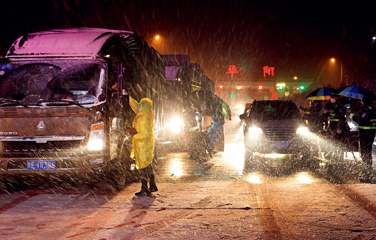
An officer checks a driver's temperature in snow at a checkpoint in Luonan County in western China's Shaanxi Province late on the night of February 5. Traffic police and health workers stayed on duty 24 hours across three shifts a day to screen passing drivers and vehicles to prevent the spread of the coronavirus.
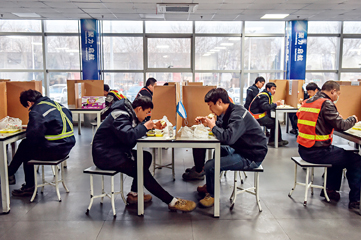
Workers at an auto parts factory employ partition boards in the cafeteria to minimize risk of droplet infection on February 12 after many companies resumed production.
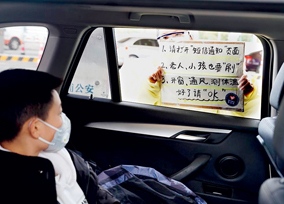
A volunteer guides a family in a car through a screening procedure at a checkpoint in Shanghai on February 14. A volunteer team worked around the clock in shifts to screen drivers, passengers and vehicles and spread knowledge of epidemic prevention at expressway checkpoints.
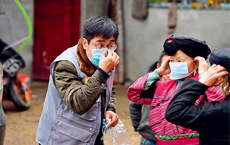
Yang Kai (left), an official from Jiangliu Village of Longsheng Ge Autonomous County in southwestern China's Guangxi Zhuang Autonomous Region, shows residents how to properly wear a mask on February 12.
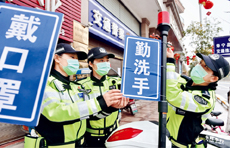
Female traffic cops put up posters with catchphrases for epidemic prevention on their motorcycles on February 13 in Ningde in southeastern China's Fujian Province. While performing traffic duties, they spread knowledge of virus containment through posters and short videos.

Returning residents pass through a “disinfecting lane” at the entrance of their residential blocks in Fuzhou, capital of Fujian Province, on February 11. Property management company set up this lane in which disinfectant is sprayed by humidifiers.

A medical worker takes a selfie at Changshui International Airport in Kunming, capital of southwestern China's Yunnan Province, before leaving for Xianning, an epidemic-stricken city in Hubei, on February 12. He was one of the 350 doctors and nurses sent by Yunnan Province to the city. Before his team, another two had already arrived at the battlefront of the virus control.

Newlyweds Zhang Lingwen (right) and Huang Miaowei (left) kiss after marriage registration in Shenzhen, southern China's Guangdong Province, on February 14. To avoid gatherings, local civil affairs authorities asked couples to make appointments before registering for marriage at their service offices.
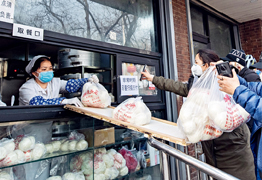
A food vendor in Beijing delivers steamed buns to customers via a self-made sliding board to avoid direct contact on February 11.
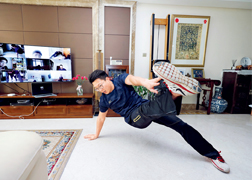
Hu Xiaoqian, a physical education teacher at Tsinghua University, uses online education devices to teach the first class of the new semester on February 17. Millions of Chinese students started remote learning through multiple channels that day.
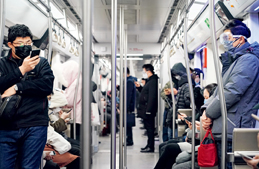
Passengers wear masks and goggles en route to work on Beijing Subway Line 6 during the morning traffic rush on February 12. Various precautions have been taken to curb the virus spread in communities, factories, companies and shopping malls.
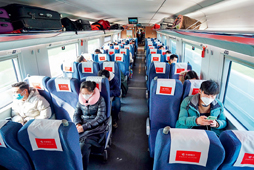
Workers from the central Chinese provinces of Henan and Anhui return to work on a free train trip sponsored by the municipal government of Kunshan, Jiangsu Province. From February 20 to 29, nearly 10,000 workers were transported by the special trains to Kunshan. Measures such as frequent temperature monitoring and scattered seats were adopted to help epidemic prevention and control.
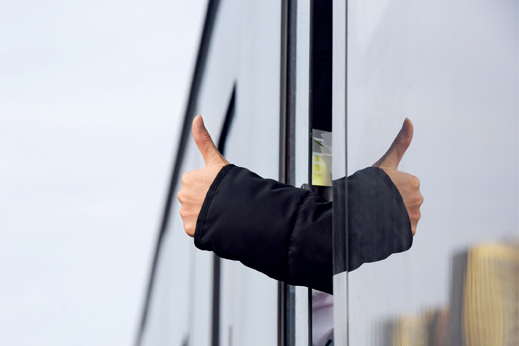
Medical workers at Huoshenshan Hospital, dedicated to treating COVID-19 patients, receive a thumbs up from a recovered patient on February 13.

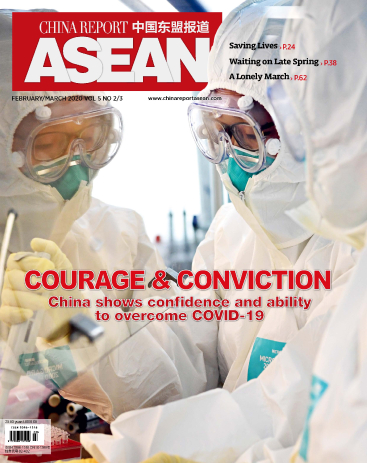
 Copy Reference
Copy Reference